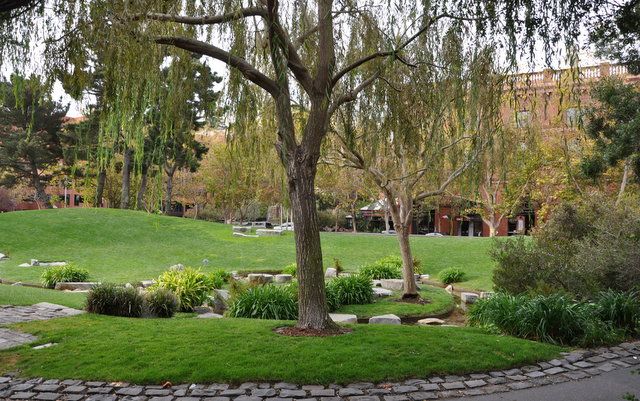How to See the Liberty Bell...in Queens
A copy of the famous American bell can be found inside a bank, which itself is modeled after Independence Hall!



In 1982, the Haas family (heirs to Levi Strauss) were looking to build a new corporate campus for the Levi Corporation. They called upon Lawrence Halprin to design the plaza for the campus. While prolific, Halprin is best known for Sea Ranch in California and the Franklin Delano Roosevelt Memorial in Washington D.C. Sometimes referred to as “Modernism’s Olmsted,” Halprin is one of the most celebrated landscape architects of the late-20th and early-21st century.
From the beginning, the Haas family requested that the company’s values be incorporated into the design. They desired a “sensitivity to detailing and high standards of workmanship” and expressed the following sentiments: “monumental architecture is not our style,” “The Plaza too should be distinctive,” and “Quality never goes out of style.”

Halprin divided his design for Levi Plaza’s five acres into two parts: a hard park and a soft park. The hard park is similar to a European plaza. The soft park was described by Halprin as a “transplanted piece of the Sierras.” In part, this is in homage to Levi Strauss himself, who got his start selling riveted, denim work pants to miners in the Sierra Nevada.
The soft park is an open space easily accessible to anyone that chooses to enter. This portion of Levi Plaza fills a triangular lot surrounded by The Embarcadero, and Battery and Union streets.

This “transplanted Sierras” includes open water, fountains and attractive nuisances (anything on a premises that might attract children into danger or harm) that would not work in another environment. Thanks to 24-hour, 365-day security, this type of appealing, open design is allowed to exist in an urban environment. Unlike public parks that are funded by tax payers and subject to public use-be it for picnics or protests like OWS-Levi’s Plaza has an autonomy that comes with private funding.

A waterfall at the end of the park is a well recognized fixture of Halprin’s designs. This waterfall flows into a gentle stream that snakes throughout the park. Lined with granite boulders that act like sculpture, the stream is caressed by artificially constructed grassy burms sheltering the visitor from noises that emanate from the streets surrounding the park.
When the park ran $4 million over budget, the Haas family chose to pay for it out of their own personal funds. They have also made provisions to keep the park maintained in perpetuity.

Levi Plaza [Map]
1155 Battery Street
San Francisco, CA
Follow Untapped Cities on Twitter and Facebook. Get in touch with the author @PQPP3.
Subscribe to our newsletter